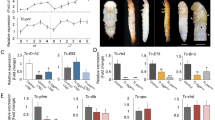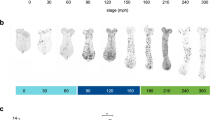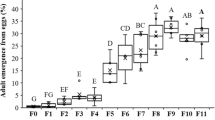Abstract
WHEN corpora allata from the same species of Lepidoptera are removed and implanted into naturally diapausing pupæ or pupæ diapausing as a result of extirpation of the brain (‘Dauer pupæ’), the recipients develop into moths or pupal–adult mixtures (second pupæ)1–4. The results obtained when donor and host are not so closely related are also of interest. Therefore, heterologous grafts of corpora allata between insects usually diapausing in the pupal and egg period respectively have been made and the effect on metamorphosis compared to homologous transplants.
This is a preview of subscription content, access via your institution
Access options
Subscribe to this journal
Receive 51 print issues and online access
$199.00 per year
only $3.90 per issue
Buy this article
- Purchase on SpringerLink
- Instant access to full article PDF
Prices may be subject to local taxes which are calculated during checkout
Similar content being viewed by others
References
Ichikawa, M., and Nishiitsutsuji-Uwo, J., Biol. Bull., 116, 88 (1959).
Williams, C. M., Biol. Bull., 116, 323 (1959).
Kobayashi, M., and Yamashita, Y., J. Sericul. Sci. Japan, 28, 335 (1959).
Kobayashi, M., Nature, 187, 346 (1960).
Ichikawa, M., and Takahashi, S., Mem. Coll. Sci. Univ. Kyoto, Ser. B, 26, 249 (1959).
Kobayashi, M., and Burdette, W. J., Proc. Soc. Exp. Biol. Med., 107, 240 (1961).
Van Der Kloot, W. G., Biol. Bull., 109, 276 (1955).
Author information
Authors and Affiliations
Rights and permissions
About this article
Cite this article
KOBAYASHI, M., BURDETTE, W. Heterologous Transplantation of Corpora Allata between Lepidoptera Diapausing in Egg and Pupal Stages. Nature 194, 401–402 (1962). https://doi.org/10.1038/194401a0
Issue date:
DOI: https://doi.org/10.1038/194401a0



